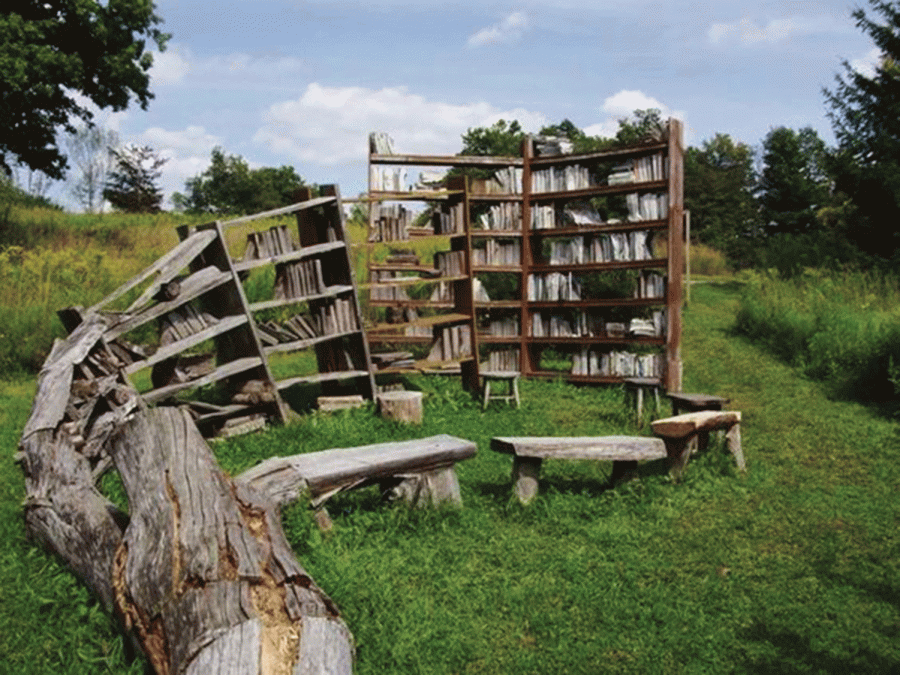A Walk On the Wild (and Artistic) Side
The stacks at Stone Quarry Hill Art Park exude an eerie feeling of a deserted library. A lot of the works featured at the park are incorporated in the natural environment.
Like most moms, mine prides herself in discovering the next coolest thing – especially when it comes to art. I assumed our drive to an art park in Cazenovia would be yet another outing to entertain her obsession with convincing me that she is, in fact, “hip.” But as we drove off Route 20 onto Stone Quarry Road, the scenery convinced me this wasn’t your average trendy art exhibit. Rusted metal sculptures interrupted the smooth, grassy hills that were illuminated by the dark November sky. As we drove through the park’s designated entrance we found no ticket office and no employees concerned about any kind of payment or donation. The system seemed to rest upon a kind of mysterious administration. My mom and I got out of the car to find no one else in sight. This wasn’t your average childhood park; this was the Stone Quarry Hill Art Park.
The story goes that in 1950, Dorothy and Bob Riester were looking to build a summer home overlooking the Cazenovia and Oneida lakes. With each year, the Riesters added to their initial 23 acre purchase, which now stretches more than 104 acres. Inspired by her own passion for art, Dorothy Riester wanted to make her beautiful property a home for local artists like herself; thus, the Stone Quarry Hill Art Park was born.
Since its inception in 1991, the art park has dedicated itself to “providing a unique environment for the showcasing of art by emerging and established artists,” according to the park’s website. Now, more than 100 sculptures of all sizes and mediums inhabit the park’s 104 acres. It features four miles of walkable trails that take you through miniature forests and grassy hills. Down one path, you’ll find circular steel signs that read “seep” in orange capital letters. Another path will lead you to a white wire door frame that looks as if it has been two-dimensionally drawn against a backdrop of leafless trees. One can only gawk at this juxtaposition of the manufactured with the natural.
In 2011, the Stone Quarry Hill Art Park was recognized as #2 in National Geographic’s “Top Ten Sculpture Parks and Trails” in Secret Journeys of a Lifetime: 500 of the World’s Best Hidden Travel Gems. It is, as the park’s website calls it, “both a museum and a landscape,” an attitude which is a part of a larger movement within the art community which speaks to concerns about the environment, climate change and sustainability.
“Stacks,” an installation designed and crafted by Cazenovia local David Harper, successfully communicates these messages. “Stacks” sits on the side of a grassy hill on the backside of the park. In order to reach the piece itself, I first had to cross the threshold of an empty doorframe that read “The Garden of Reading.” Three broken down bookshelves sat on the other side of the door, mimicking the scene of an abandoned library. I felt a lingering intimacy as I recognized the titles of withered and torn books. Adding to this feeling was the sight of wooden benches situated in a circle as if children had once gathered there to read. Despite my mom being the only person in sight, the longer I stayed there, the more unwelcome I felt. This same kind of discomfort is unavoidable as you explore the park. Undesirable as that sounds, this discomfort forces you to acknowledge the role that nature plays in contributing to the beauty of each sculpture. For Colgate students looking to take a walk on the wild (and artistic) side, the Stone Quarry Hill Art Park is the perfect place to do so.







